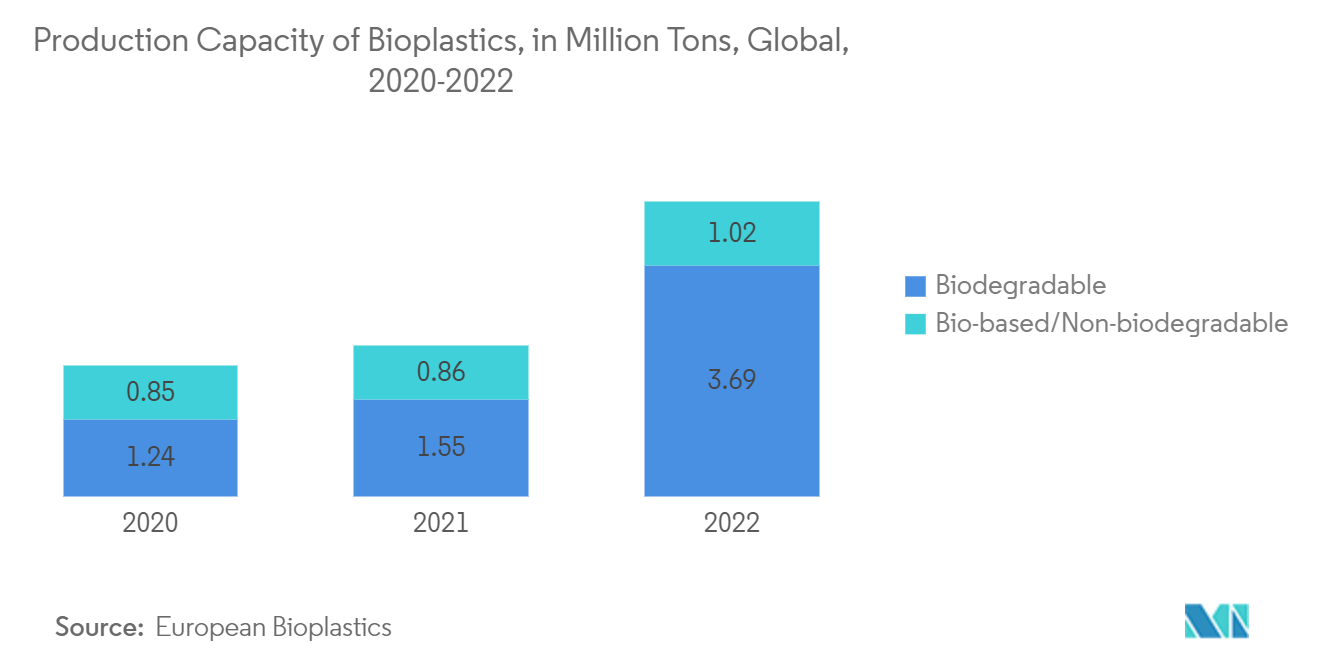Market Trends of Bio-based Polypropylene Industry
This section covers the major market trends shaping the Bio-based Polypropylene Market according to our research experts:
Growing Demand from Injection Molding Application
- Due to its high melting point, good fatigue properties, heat and chemical resistivity, and eco-friendly nature, bio-based polypropylene is used in various injection molding applications in packaging, automotive, electronics, and medical industries.
- The demand for bio-based polypropylene in packaging applications, such as wrapping organic food and premium and branded products with particular requirements, is rising steadily.
- Moreover, governments worldwide are promoting bioplastic packaging in the context of various policies for innovation, resource efficiency, and climate change.
- According to a recent consumer study, sustainability is a valuable purchase criterion for 60% of consumers globally, with the US boasting a percentage a little above the global average at 61%.
- Furthermore, China is significantly involved in producing high amounts of plastics, generating revenues from trade exports. It is, thereby, creating significant production capacities for various packaging companies. According to ITC, in 2021, China exported plastics and articles valued at about USD 131.07 billion, a 36% rise in exports from the previous year (2020), valued at around USD 96.38 billion.
- The global production capacity of bioplastics increased by 16% in 2021 to 2.4 million metric tons. Biodegradable bioplastics accounted for 1.6 million metric tons of the total capacity in 2021.
- According to the injection mold specialist SFA Packaging from Middelharnis, most foods come in injection mold packaging made of polypropylene.
- Due to environmental concerns, more consumers and manufacturers are preferring eco-friendly packaging options, boosting the demand for the bio-based polypropylene market.

Europe to Dominate the Market
- Europe is a significant hub for the bio-based polypropylene industry, with about 50% of the market share. It ranks high in R&D in this industry.
- Government regulations in most European countries regarding using bio-degradable plastics, including bio-based polypropylene, are stringent. The government is continuously pushing the usage of eco-friendly products.
- Bio-based polypropylenes are majorly used in the packaging industry. Europe is one of the leading consumers in the packaging industry and is developing various packaging segments.
- Germany is the largest plastic consumer in Europe. The increasing plastic usage in the packaging industry propelled the plastic demand. In 2021, the packaging industry in Germany generated EUR 29.6 billion (USD 34.55 billion) in revenue. It decreased compared to the previous year to EUR 26.3 billion (USD 30.70 billion).
- Moreover, the German government is promoting bio-based and recycled materials used in the packaging industry. For instance, Germany's Bundesrat, the upper house of parliament, approved a new packaging law to boost the recycling of packaging waste. It is an important signal for the bioplastics industry as, for the first time, bio-based and recycled materials are recognized as equally viable solutions to make packaging more sustainable and reduce our dependency on finite fossil resources.
- Additionally, the popularity of the e-commerce segment and the growing retail market gave a vast growth opportunity to the bio-based polypropylene market in the region through the years.
- In 2021, the B2C e-commerce sector in Germany generated around EUR 86.7 billion (USD 101 billion). Online shopping is on the rise after COVID-19 spread across the globe. In the e-commerce sector, Germany was in sixth place after China, the United States, Great Britain, Japan, and South Korea, in 2021. In particular, mobile commerce is becoming increasingly important. Currently, 7.26 billion people use smartphones, and this is estimated to reach 7.5 billion by 2026.
- The abovementioned factors are expected to drive the market for bio-based polypropylene in Europe in the coming years.


